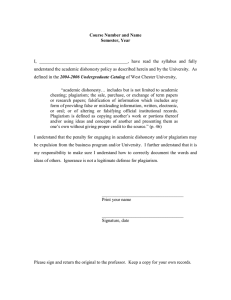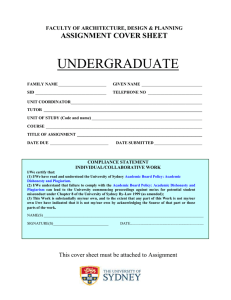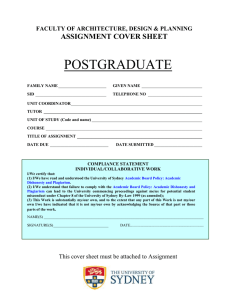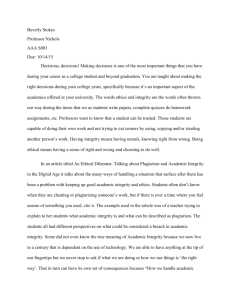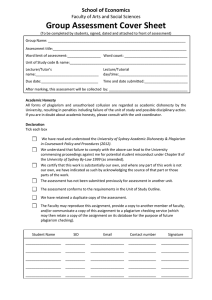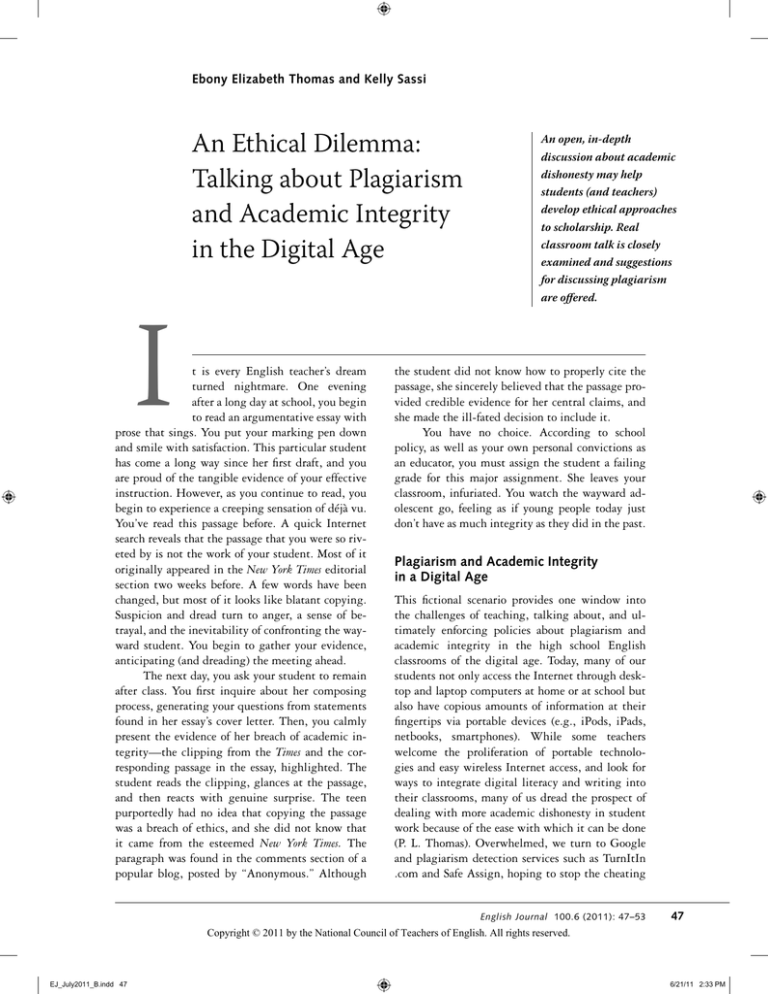
Ebony Elizabeth Thomas and Kelly Sassi
An Ethical Dilemma:
Talking about Plagiarism
and Academic Integrity
in the Digital Age
I
t is every English teacher’s dream
turned nightmare. One evening
after a long day at school, you begin
to read an argumentative essay with
prose that sings. You put your marking pen down
and smile with satisfaction. This particular student
has come a long way since her first draft, and you
are proud of the tangible evidence of your effective
instruction. However, as you continue to read, you
begin to experience a creeping sensation of déjà vu.
You’ve read this passage before. A quick Internet
search reveals that the passage that you were so riveted by is not the work of your student. Most of it
originally appeared in the New York Times editorial
section two weeks before. A few words have been
changed, but most of it looks like blatant copying.
Suspicion and dread turn to anger, a sense of betrayal, and the inevitability of confronting the wayward student. You begin to gather your evidence,
anticipating (and dreading) the meeting ahead.
The next day, you ask your student to remain
after class. You first inquire about her composing
process, generating your questions from statements
found in her essay’s cover letter. Then, you calmly
present the evidence of her breach of academic integrity—the clipping from the Times and the corresponding passage in the essay, highlighted. The
student reads the clipping, glances at the passage,
and then reacts with genuine surprise. The teen
purportedly had no idea that copying the passage
was a breach of ethics, and she did not know that
it came from the esteemed New York Times. The
paragraph was found in the comments section of a
popular blog, posted by “Anonymous.” Although
An open, in-depth
discussion about academic
dishonesty may help
students (and teachers)
develop ethical approaches
to scholarship. Real
classroom talk is closely
examined and suggestions
for discussing plagiarism
are offered.
the student did not know how to properly cite the
passage, she sincerely believed that the passage provided credible evidence for her central claims, and
she made the ill-fated decision to include it.
You have no choice. According to school
policy, as well as your own personal convictions as
an educator, you must assign the student a failing
grade for this major assignment. She leaves your
classroom, infuriated. You watch the wayward adolescent go, feeling as if young people today just
don’t have as much integrity as they did in the past.
Plagiarism and Academic Integrity
in a Digital Age
This fictional scenario provides one window into
the challenges of teaching, talking about, and ultimately enforcing policies about plagiarism and
academic integrity in the high school English
classrooms of the digital age. Today, many of our
students not only access the Internet through desktop and laptop computers at home or at school but
also have copious amounts of information at their
fingertips via portable devices (e.g., iPods, iPads,
netbooks, smartphones). While some teachers
welcome the proliferation of portable technologies and easy wireless Internet access, and look for
ways to integrate digital literacy and writing into
their classrooms, many of us dread the prospect of
dealing with more academic dishonesty in student
work because of the ease with which it can be done
(P. L. Thomas). Overwhelmed, we turn to Google
and plagiarism detection services such as TurnItIn
.com and Safe Assign, hoping to stop the cheating
English Journal 100.6 (2011): 47–53
47
Copyright © 2011 by the National Council of Teachers of English. All rights reserved.
EJ_July2011_B.indd 47
6/21/11 2:33 PM
An Ethical Dilemma: Talking about Plagiarism and Academic Integrity in the Digital Age
and copying that have allegedly “reached epidemic
proportions” in student writing (Purdy). However,
there are issues of intellectual property involved in
using such sites—once a student uploads his or her
paper, it becomes part of the database used to check
for future plagiarism cases. The intellectual property caucus of the Conference on College Composition and Communication generally advises against
the use of plagiarism detection services as a policing tool.
The digital intimacy
After all, we are teachers, not
cultivated in virtual
police, so many of us dutifully
communities may
teach our students how to cite
conflict with those of
sources, then are disheartened
academic English.
when we must enforce harsh
penalties for those students
who are unwilling (or don’t know how) to give
credit where credit is due.
The consequences of plagiarism are what
Rebecca Moore Howard famously characterized as
the “academic death penalty.” Margaret Price further characterizes the tone of plagiarism policies in
many of our writing classrooms as “gotcha!” pedagogy. Price observes that “plagiarism is not only a
phenomenon that can be mastered by students new
to academic writing, such policies announce, it must
be mastered” (89; italics added). The consequences
for even unwitting student plagiarists are often severe, ranging from failing grades on assignments to
expulsion from a course or even a school.
Students and scholars are expected to cite
all instances of others’ ideas and creativity in their
work, but teachers—and this might bear further
exploration—are not expected to cite the contributions of others in our teaching materials. The rules
and norms of one community or group may be distinct from those of another (Swales). In this way,
perhaps our students are not unlike us. As digital
natives, some students may be engaged in digital
writing in contexts where norms of integrity are
quite different from those assumed by classroom
teachers (Prensky). The adolescents in our classrooms, many of whom were born just as the World
Wide Web exploded (or later), regularly use social
networking sites such as Facebook, MySpace, and
Twitter, as well as blogs, wikis, instant messaging,
texting, and YouTube. Before they were old enough
for a Facebook account, many elementary school–
age children were initiated into collaborative mul-
48
timodal composing with the debut of the Nintendo
DSi in April 2009, which allowed instant sharing
of Flipnotes and other digital compositions all over
the world. Today’s children and young adults use
these forms of communication to engage in textual and visual production that is collaborative,
patched together with pastiche and allusions, and
shared in what has been characterized as environments of digital intimacy (Thompson). Although
both digital literacy and digital intimacy can be
used to scaffold student learning of written genres
that are privileged in schools, the virtual communities where these projects are shaped have their
own ever-evolving rules, norms, and assumptions
about integrity and what constitutes appropriate
authorship. For example, on many fanfiction sites,
participants are using the characters, plot, symbols,
etc. of a well-known work, but these authors are
not immune to charges of plagiarism. The digital
intimacy cultivated in virtual communities may
conflict with those of academic English. Traditional
writing tasks, such as timed, high-stakes writing
tests, put tremendous pressure on students to perform. Left unexamined, conflicts between the intellectual property conventions of traditional forms
of writing and highly social, multimodal compositions boil over into difficult conversations. Therefore, talking and teaching about academic integrity
in high school English classrooms may lead to an
ethical dilemma—a dilemma in need of an effective
resolution.
Jane’s Ethical Dilemma: Talking
about Plagiarism with Students
Ebony, the first author of this article, first met Jane
Bradshaw while teaching ninth grade at a new
school. At the time, Ebony’s teaching practices
were being researched by a doctoral student, Kelly,
the second author of this article (Sassi and Thomas).
After the study was concluded, Kelly and Ebony
wrote about how they resolved ethical dilemmas
that arose during the teaching of multicultural
literature through the intervention of a “privilege
walk” (Sassi and Thomas). Two years later, Ebony
returned to Rainfield High School to conduct her
own dissertation research on ethical dilemmas that
other English teachers might face (Thomas). To
find out what kinds of topics teachers were hav-
July 2011
EJ_July2011_B.indd 48
6/21/11 2:33 PM
Ebony Elizabeth Thomas and Kelly Sassi
ing difficulty talking about with their students,
she convened a series of professional development
workshops for ninth- and tenth-grade English
teachers. Teachers were invited to learn about discourse analysis while recording the talk in one of
their classes for a month. One of the primary texts
used was Lesley A. Rex and Laura Schiller’s Using
Discourse Analysis to Improve Classroom Interaction,
which provided a framework for teachers interested
in investigating their own discourse. Each teacher
in the group then selected a conflict-laden moment
to analyze, and then reflected on what they learned.
All of the teachers had different kinds of dilemmas that they were wrestling with in their
classrooms. One of Ebony’s colleagues who wrestled
most with how to talk with her students about
plagiarism was Jane Bradshaw. Jane’s dilemma
that she talked about during the workshops was,
How do you negotiate classroom norms with students who
choose to define ethics, originality, and plagiarism very
differently than you do? Her students were devising
increasingly creative ways to cheat on quizzes and
papers. Jane responded to this initially by remaining firm about her values and convictions about academic integrity in the English classroom, and she
was discouraged that even after an initial conversation surfacing her concerns, students continued to
justify their behaviors and choices. She was clearly
frustrated with the increase in academic dishonesty
and voiced her frustrations in our workshops, but
she was not sure about how to proceed other than to
enforce consequences.
Jane’s ethical dilemma is a common one
among English teachers. English class is the site
where secondary students are first introduced to the
humanities. As such, it has the humanistic goal of
creating a citizen who is not only literate but also
ethical and cosmopolitan (Alsup et al.). Through
our teaching of literature and writing, we also teach
the ethical values of our society. As such, what is
taught in English classrooms and how it is taught
is highly contested and often politicized. Australian
language and literacy educators Frances Christie
and Mary Macken-Horarik propose that the reason
why English can be so contested is because the main
goal for our students is the acquisition of an acceptable shared ethical position. Students not only demonstrate their proficiency in English studies through
their knowledge of language, literature, and writ-
ing but also through demonstrating that one shares
and has internalized prevailing social and cultural
norms (Christie and Macken-Horarik). One of these
norms is that of academic integrity, which consists
of sole authorship and attributing all sources that
contribute to a written work.
When teachers like Jane are attempting to
establish a shared ethical position, ideological dilemmas are often a source of conflict. Yet through
talking about points of difference, tension, and
conflict, often teachers and students are able to find
common ground. Some teachers even learn to welcome conflict as generative for critical teaching and
learning (Dakin; Gutierrez, Baquedano-Lopez, and
Tejeda; Souto-Manning).
As Ebony listened to Jane share about her
students’ academic dishonesty during the discourse workshops, she began to consider whether
Jane and her students were on the same page about
what terms such as plagiarism and academic integrity
meant. From her previous experiences teaching at
Rainfield and her teacher research with Kelly, she
knew that effective cross-cultural and cross-contextual communication was complex at this increasingly diverse school. To that end, she suggested
that Jane have a brief conversation with her stuThrough our teaching of
dents about how they were
literature and writing,
thinking about these ideas.
we also teach the ethical
Ebony would record and
values of our society. As
transcribe the conversasuch, what is taught in
tion, and together she and
Jane would then analyze
English classrooms and
the ways that students were
how it is taught is highly
talking about plagiarism
contested and often
and academic integrity.
politicized.
Jane agreed and graciously
allowed Ebony to visit her
ninth-grade honors/pre-AP classroom as a participant and observer. Students read the last scene of
act 2 of Romeo and Juliet, and then Jane shifted into
talking about plagiarism.
Jane opened the discussion by explaining
what they would be talking about and why it was
important both now and in the future:
Jane: OK, good. (pauses) I know that this
comes to mind for me a lot, and I’ve mentioned it a couple of times already this year,
but I think that it’s a good time to mention
English Journal
EJ_July2011_B.indd 49
49
6/21/11 2:33 PM
An Ethical Dilemma: Talking about Plagiarism and Academic Integrity in the Digital Age
it again. Because tomorrow we’re having a
quiz on act 3. I’ve told you [academic dishonesty] has been an extra concern to me this
year for my ninth graders. One thing that’s
important to reinforce . . . is the whole idea
of how you’re shaping your future . . . how
you’re shaping the person that you want to
be. Sometimes, there might be a difference in
opinion about what exactly is academic dishonesty. So when I say that term, what do you
think of?
Jane set up the talk by shifting the focus from
the literature under study to the ethics that her students needed to learn. They needed to consider how
they were “shaping their future” and “the person that you
When the discussion
want to be” when they were
turned to consideration
engaged in academic dishonof plagiarism, the
esty. She expressed to them
conversation shifted
that it is “an extra concern
from consequences for
to me this year for my ninth
graders,” reinforcing her ethic
academic dishonesty to
of care in the classroom. She
teaching about academic
also showed that she valued
integrity.
her students’ opinions by asking them what they thought
about plagiarizing and cheating on assignments.
At first, students were reluctant to speak. The
classroom atmosphere and students’ body language
seemed tense. After the first few minutes, students
began to speak more freely. Below, we categorize
some of the ways that Jane and her students talked
about academic integrity.
How Jane’s Students Defined
Academic Dishonesty
Some of the terms generated during Jane’s discussion included texting during tests, plagiarism, and
copying. We use these terms to categorize what students said because it is important to not only teach
students about policies and provide examples of
citations but to also understand their preconceived
notions about what constitutes academic integrity.
Texting during Tests
Elise: Texting during tests. That’s cheating.
Jane: Texting during tests . . . cheating is
another way of saying academic dishonesty.
50
I’m talking about not cheating on your
income tax, but rather cheating . . . throughout your education.
Jane redefined her student’s label of “cheating” with the more scholarly term academic dishonesty. She gave the term more weight by describing
academic dishonesty in the same vein as cheating
the IRS. Her “but rather” positioned cheating
“throughout your education” as the equivalent to
(or even greater than) the felony of tax evasion. Her
choice of words emphasized the gravity of texting
anything during a test for students who may not
have understood that their usual digital literate
practice was not just a minor crime but also a serious breach of academic integrity.
Plagiarism
Jane: Plagiarism? Can you tell us a little
more about what that is?
Mia: It’s like . . . instead of doing your own
thing, you go and get someone else’s off the
Internet or something?
Jane: Right! It’s fairly easy these days for
teachers to check on that. There are some
software packages, but in addition to that,
there are other really quick ways to type in a
phrase, you know. Teachers are pretty good at
noticing the way that students express themselves. . . . Another good point is that . . .
yes, if it’s a direct quotation, you need to cite
that source, but . . . any kind of paraphrase . . . you still have to cite the source.
When the discussion turned to consideration
of plagiarism, the conversation shifted from consequences for academic dishonesty to teaching about
academic integrity. Jane first alluded to software
programs that detect plagiarism, then began to
chat about what kinds of information need attribution. This points to Jane’s interest in punishing her
students but also teaching them the conventions of
the field.
Copying
Aidan: Copying?
Jane: Copying. So kind of looking at someone else’s answers during a test. But what
about copying, like study guides, if it’s not,
July 2011
EJ_July2011_B.indd 50
6/21/11 2:33 PM
Ebony Elizabeth Thomas and Kelly Sassi
like, a group project or something like that?
Does that . . . is that what you’re thinking?
Aidan: It’s . . . still cheating.
Jane: It’s cheating in what way?
Aidan: Um, you’re not doing it yourself, so
you’re cheating yourself.
Jane: It’s all about setting our own standards . . . the worst thing in the world is to
cheat ourselves.
Jane distinguished between two different
kinds of “copying.” The first kind was copying
answers from someone else’s test. The second was
copying verbatim from study guides and other materials, but a qualification was added—“a group
project or something like that.” This pointed to
one category of assignment where students could engage in what in other contexts might be considered
copying. Although this distinction was not explicitly stated, Jane advises students to “set their own
standards” so that they will not “cheat” themselves.
How Jane’s Students Rationalized
Academic Dishonesty
As the conversation progressed, Jane’s students
began to rationalize their choices about whether or
not to engage in what their teacher believed was
academic dishonesty. One of Jane’s major concerns
was that information about her literature quizzes
was being provided from students who had already
taken her class.
The conversation continued for several more
minutes. Students repeatedly drew distinctions between knowledge of test content and degree of difficulty, and providing actual questions and prompts.
Although Jane insisted that both categories constituted academic dishonesty, students did not understand why asking “How was the test?” or “What
kinds of topics were covered?” was considered cheating by Jane. Even one student, Elise, who acknowledged that teachers “can’t give all their classes the
same test at the same time,” drew these distinctions.
The discussion ended with talk about changes
in ethics over time. Samantha, another student,
expressed frustration, saying, “I don’t get why it’s
cheating when it’s just polite conversation!” may
seem like excuse-making for those like Jane (who
“deliberately avoided that kind of conversation”),
but for teens growing up during an age where digital intimacy means that some teens tweet, text,
Facebook, and video their way through the day,
dishing about what a teacher wanted you to know
about Shakespeare is considered a kind of collective
sharing. Amelie rejects the deficit framing of the
conversation as “academic dishonesty” by telling
her teacher that “values . . . have changed a lot.”
She pointed out the differences between the expectations of students when Jane was in high school
and the pressures that she and her peers face today.
What Jane Learned from
Analyzing Her Teacher Talk
After Jane talked about academic integrity with
her students, she sat down with Ebony to view the
video and to examine the differences between the
ways that she defined and characterized academic
integrity, academic dishonesty, and plagiarism, and
how her students did so. Together, Jane and Ebony
generated the categories delineated above. Jane
then wrote a brief reflection about the experience,
listing her ideas and notes for teaching:
Jane’s Thoughts
It’s important to highlight ways in which
academic dishonesty can be expressed (different forms).
Students’ positioning and relationships to
academic integrity are interesting to observe.
Underlying values are relevant.
Do students care? To what extent and about
what? Getting caught—or?
What are other directions this conversation
might have taken?
Language that invites open listening as
opposed to defensive positioning on the part
of students is important. (Even with neutral,
as opposed to accusatory, language, they seem
to “defend” the value of academic dishonesty!
Curious about why they tried to justify it.)
Language addressing values and morals can
be inflammatory—it is important to keep
emotions out as much as possible and yet
sometimes it is important to dramatize
strong feelings.
English Journal
EJ_July2011_B.indd 51
51
6/21/11 2:33 PM
An Ethical Dilemma: Talking about Plagiarism and Academic Integrity in the Digital Age
Jane concluded by writing, “Students seemed
open, and they demonstrated the ability to think
critically (at least some did). Some students were
not operating in the realm of logic. It is important
to listen to them and show respect even when I disagree with their opinions. It takes patience and restraint to listen and then draw ideas together.”
Conclusion: Uploading Plagiarism 2.0
How we handle academic integrity with our students has implications beyond our individual
classrooms. As educators, we make important distinctions when we evaluate student assignments
for different purposes. We may ask our students to
bring in direct quotes about a topic or from a novel,
and for doing so, they receive full credit on an assignment. To us, the distinctions between smaller
assignments that build student understanding,
help stimulate ideas for prewriting, or develop collaborative skills, and essays, projects, and exams
intended for final, independent evaluation of student capabilities, are clear. For our students, they
may not be. Although, like Jane’s student Aidan,
they may parrot our rationales—“you’re cheating
yourself”—whether or not all students fully understand them (and the ethics that underpin them) is
questionable.
Our aim as teachers of writing is to develop
students’ ability to put “ideas, questions, and problems into words, mulling them over so they can see
them from different angles
and reason their way . . . to
How we handle
where they want to stand”
academic integrity
(Rex, Thomas, and Engel 56).
with our students has
To that end, Price and Howimplications beyond our
ard offer insight into how,
individual classrooms.
like Jane, we might shift our
writing pedagogy from merely
policing plagiarism toward engaging in rich conversations with students about academic integrity:
1. Socialize students into discourse
communities of academic writing by
providing invitations for students to
“question and discuss plagiarism”
(Price 105).
2. Acknowledge that what constitutes
plagiarism is context dependent. Indicate in
written policies that citation is a convention,
52
and “conventions shift across time and
locations” (Price 106).
3. Provide clarity about the historical origins of
and contemporary rationales for citations in
academic writing (Howard 789).
4. Acknowledge alternate ideas about
authorship, including oral traditions and
voice merging, and other perceptions about
originality that come from nonwestern
cultures, which many of our students and
their families come from (Howard 792).
5. Invite students to practice different kinds of
ways of attributing outside sources and their
own work (Price 108–09).
The ways that we talk about plagiarism and
academic integrity in the digital age pose new
challenges never seen before in the profession.
High school teachers are grappling with the same
issues that college composition instructors are
taking up; see, for example, the CCCC statement
on “Transforming Our Understanding of Copyright and Fair Use” (http://www.ncte.org/cccc/
committees/ip/ipreports/transforming). It is difficult to anticipate what new ethical dilemmas will
arise. For example, while multimodal composing
has brought with it an acknowledgment of patchwriting as a strategy that digital natives often use,
there are still situations—writing on demand is
one of them—when students will have to write
convincingly without the aid of the Internet and
access to the ideas of others (Gere, Christenbury,
and Sassi). While not engaged in this kind of academic writing, however, students may choose to
make their work public in a number of ways. For
example, they may choose to use the tools in the
creative commons to publish their work. The designers of Creative Commons “work to increase
the amount of creativity (cultural, educational,
and scientific content) in ‘the commons’—the
body of work that is available to the public for free
and legal sharing, use, repurposing, and remixing” (“What”). Just as we have always had an obligation to teach students the positive traits that
help them avoid plagiarism, such as citing sources
correctly, we now need to learn what kinds of materials are free for the remixing that is a hallmark
of students’ digital literacy.
It’s time to upload Plagiarism 2.0—the old
rules no longer apply.
July 2011
EJ_July2011_B.indd 52
6/21/11 2:33 PM
Ebony Elizabeth Thomas and Kelly Sassi
Works Cited
Alsup, Janet, et al. “The State of English Education and a
Vision for Its Future: A Call to Arms.” English Education 38.4 (2006): 278–94. Print.
Christie, Frances, and Mary Macken-Horarik. “Building
Verticality in Subject English.” Language, Knowledge,
and Pedagogy: Functional Linguistic and Sociological Perspectives. Ed. Frances Christie and James R. Martin.
London: Continuum, 2007. Print.
Dakin, Mary Ellen. “The Case for Conflict in Our Classrooms.” English Journal 97.3 (2008): 12–14. Print.
Gere, Anne Ruggles, Leila Christenbury, and Kelly Sassi.
Writing on Demand: Best Practices and Strategies for Success. Portsmouth: Heinemann, 2003. Print.
Gutierrez, Kris D., P. Baquedano-Lopez, and C. Tejeda.
“Rethinking Diversity: Hybridity and Hybrid Language Practices in the Third Space.” Language, Literacy and Education: A Reader. Ed. Sharon Goodman,
Teresa Lillis, Janet Maybin, and Neil Mercer. Trent,
UK: Trentham, 2003. 171–87. Print.
Howard, Rebecca Moore. “Plagiarisms, Authorships, and
the Academic Death Penalty.” College English 57.7
(1995): 788–806. Print.
Prensky, Marc. “Digital Natives, Digital Immigrants Part
1.” On the Horizon: The Strategic Planning Resource for
Education Professionals 9.5 (2001): 1–5. Print.
Price, Margaret. “Beyond ‘Gotcha!’: Situating Plagiarism in
Policy and Pedagogy.” College Composition and Communication 54.1 (2002): 88–115. Print.
Purdy, James P. “Anxiety and the Archive: Understanding
Plagiarism Detection Services as Digital Archives.”
Computers and Composition 26 (2009): 65–77. Print.
Rex, Lesley A., and Laura Schiller. Using Discourse Analysis
to Improve Classroom Interaction. New York: Routledge,
2009. Print.
Rex, Lesley A., Ebony Elizabeth Thomas, and Steven Engel.
“Applying Toulmin: Teaching Logical Reasoning
and Argumentative Writing.” English Journal 99.6
(2010): 56–62. Print.
Sassi, Kelly, and Ebony Elizabeth Thomas. “Walking the
Talk: Examining Privilege and Race in a NinthGrade Classroom.” English Journal 97.6 (2008):
25–31. Print.
Souto-Manning, Mariana. Freire, Teaching, and Learning:
Culture Circles across Contexts. Counterpoints: Studies
in the Postmodern Theory of Education. Ed. Joe L.
Kincheloe and Shirley R. Steinberg. New York: Peter
Lang, 2009. Print.
Swales, John. Genre Analysis. Cambridge: Cambridge UP,
1990. Print.
Thomas, Ebony Elizabeth. “‘We’re Saying the Same Thing’:
How English Teachers Negotiated Solidarity, Identity, and Ethics through Talk and Interaction.” Dissertation. Univ. of Michigan, 2010. Print.
Thomas, P. L. “Of Flattery and Thievery: Reconsidering
Plagiarism in a Time of Virtual Information.” English
Journal 96.5 (2007): 81–84. Print.
Thompson, Clive. “Brave New World of Digital Intimacy.”
New York Times 7 Sept. 2008. Web. 24 Mar. 2011.
<http://www.nytimes.com/2008/09/07/magazine/
07awareness-t.html>.
“What Is Creative Commons?” Creative Commons. Web.
15 Nov. 2010. <http://creativecommons.org/about/
what-is-cc>.
Ebony Elizabeth Thomas is assistant professor of reading, language, and literature education at Wayne State University.
A former Detroit Public Schools teacher, her interests include English language arts classroom interaction, adolescent literatures
and literacies, and discourse analysis. Her coedited volume with Shanesha Brooks-Tatum, Reading African American Experiences in the Obama Era: Theory, Advocacy, Activism (Peter Lang, 2011), will be published this fall. Email her at eethomas@
wayne.edu. Kelly Sassi is assistant professor of English and education at North Dakota State University. A former high school
teacher in Fairbanks, Alaska, her interests include teacher education, composition, and Native American/American Indian literatures. Sassi has coauthored Writing on Demand: Best Practices and Strategies for Success (Heinemann, 2005) and A Student Guide to Writing on Demand: Strategies for High-Scoring Essays (Heinemann, 2006) with Anne Ruggles Gere and Leila
Christenbury. She may be contacted at Kelly.Sassi@ndsu.edu.
R E A D W R I T E T H I N K C O N N E C T I ON
Lisa Storm Fink, RWT
In “Technology and Copyright Law: A ‘Futurespective,’” students research past copyright disputes and their
relation to technology innovations before predicting future copyright disputes that may arise from technological
advancements. Students sort images of technology advancements into chronological order and compare them
with changes in copyright law. Next, students research and report on several instances that show how copyright
laws have adapted to encompass new technologies and discuss the role of technology innovations in recent
copyright disputes. Students brainstorm emerging technologies or technologies that they think will be adapted
or invented in the future. Finally, they write newspaper articles predicting the outcome of current copyright disputes related to technology and predicting copyright issues that may arise with new and future technologies.
http://www.readwritethink.org/classroom-resources/lesson-plans/technology-copyright-futurespective-1075.html
English Journal
EJ_July2011_B.indd 53
53
6/21/11 2:33 PM

